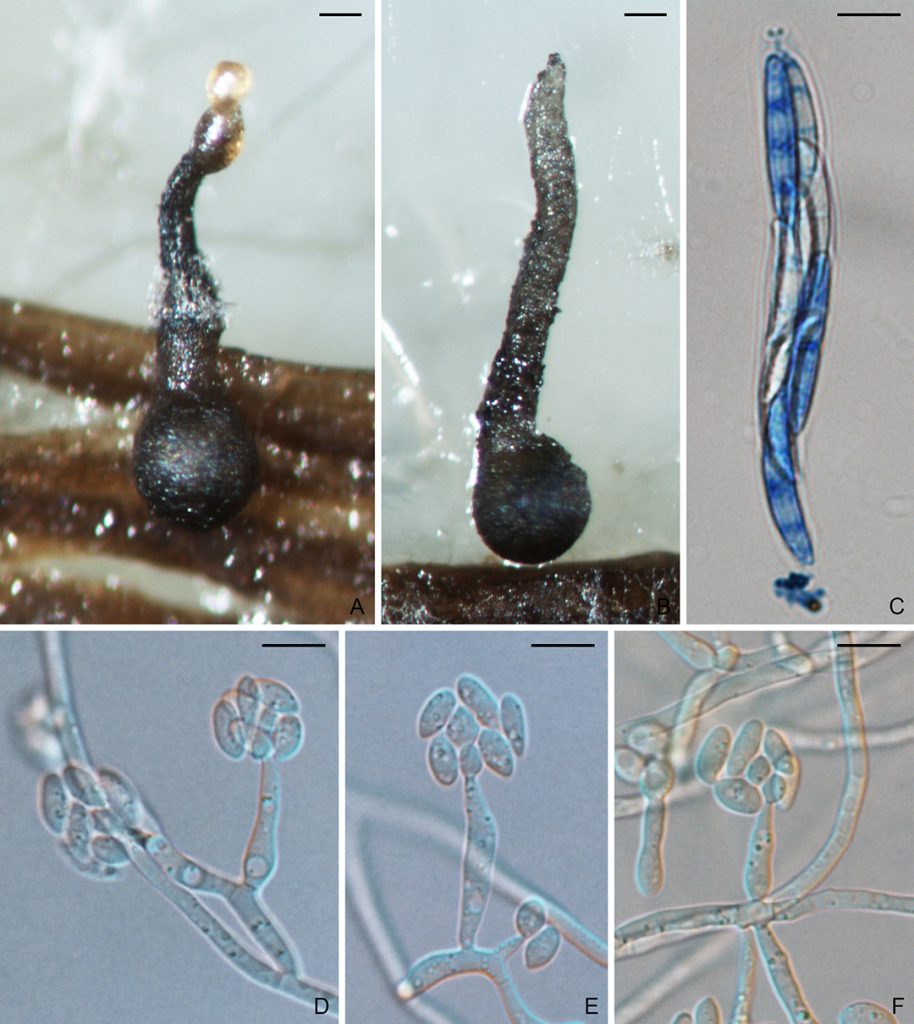
Figure. Magnaporthiopsis poae (M47 X M48). A–B. Ascomata. C. Ascus and ascospores. D–F. Conidiophores and conidia. Scale bars: A–B = 100um; C–F = 10µm.
Magnaporthiopsis poae (Landsch. & N. Jacks.) J. Luo & N. Zhang., Mycologia 105(4): 1024 (2013).
MycoBank: MB802973.
≡ Magnaporthe poae Landsch. & N. Jacks. Mycol. Res. 93:59 (1989).
Ascomata perithecial, superficial or submerged, solitary or gregarious, dark brown to black, 230–500 µm diam, with a cylindrical, hyaline to brownish neck, 300–650 × 100–135 µm. Paraphyses septate, hyaline, dissolving at maturity. Asci 8-spored, unitunicate, clavate, 60–100 × 8–15 µm, with a refractive ring. Ascospores 1–4-seriate, fusiform, straight or slightly curved, 3-septate, not or slightly constricted at septum, unequally colored, smooth, 20–40 × 3.5–5.5 µm, with darkly pigmented inner cells. Asexual state phialophora-like. On CMA, hyphae branched, septate, hyaline to light brown, smooth, 2–5 µm diam. Conidiophores micronematous, solitary, erect, straight or curved, unbranched or sparsely branched, hyaline, smooth, 1–4-septate, 5–40 × 3–6.5 µm. Conidiogenous cells phialidic, erect, terminal or intercalary, hyaline, smooth, 5–20 × 2–6 µm. Conidia aggregated in slimy heads, ovoid to ellipsoidal, straight or slightly curved, aseptate, hyaline, smooth, 3–9 × 2–5 µm.
Colonies on PDA 7 cm diam after 7 days at 25 °C in dark; surface floccose, parrot green; aerial mycelium yellowish; reverse cedar green. Colonies on CMA reaching 6.5 cm after 7 days in dark at 25 °C; surface pale yellow green; aerial mycelium sparse; reverse pale yellow green.
Typification: Holotype DAR59044. Ex-holotype culture ATCC64411, ATCC64412.
Gene sequences: JF414860 (18S), JF414836 (ITS), JF414885 (28S), JF710390 (MCM7), JF710433 (RPB1), JF710415 (TEF1).
Genome sequences: ADBL01000000 (genome).
Specimens examined: USA, California, Nipomo, on Festuca, 19 Sep. 2018, D. Mosdell, RUTPP180919a3, RUTPP180919d1; New Jersey, New Brunswick, on Poa pratensis, 11 Aug. 2011, S. Zhao and L. Bierns, M47, M48; ibid., Adelphia, on Poa pratensis, 22 Aug. 2018, P.L. Vines, RUTPP11s-1, RUTPP1213-1, RUTPP14t-1, RUTPP1412-10, RUTPP1416-1; New York, on unknown host, 25 Aug. 2018, S. Tirpak and R. Buckley, RUTPPd29709-13.
Hosts/substrates: From Poaceae.
Distribution: Canada (Ontario), China, USA (California, New Jersey, New York).
Notes: Magnaporthiopsis poae infects turf roots, crowns, and leaf sheaths, and causes summer patch disease on Kentucky bluegrass (Poa pratensis), annual bluegrass (Poa annua), fine fescue (Festuca), perennial ryegrass (Lolium perenne), and bentgrass (Agrostis). The summer patch disease has been primarily reported in temperate regions of North America, ranging from Canada (Ontario) to USA from New Jersey and North Carolina as far west as California.
Copyright 2022 by The American Phytopathological Society. Reproduced, by permission, from Luo, J., and Zhang, N. 2022. The Rice Blast Fungus and Allied Species: A Monograph of the Fungal Order Magnaporthales (https://my.apsnet.org/APSStore/Product-Detail.aspx?WebsiteKey=2661527A-8D44-496C-A730-8CFEB6239BE7&iProductCode=46826). American Phytopathological Society, St. Paul, MN.